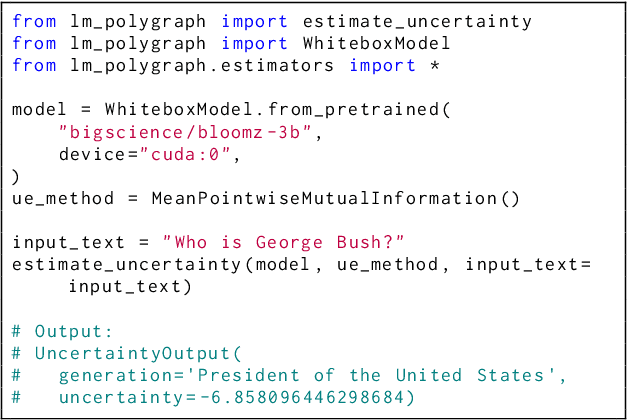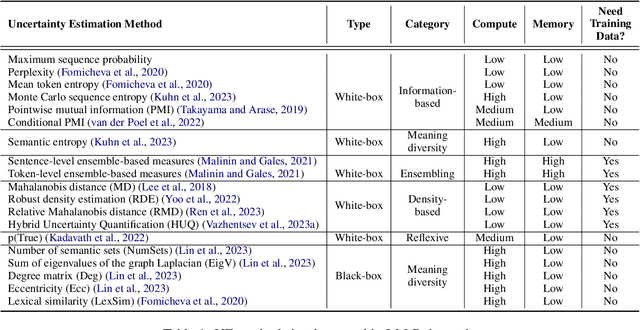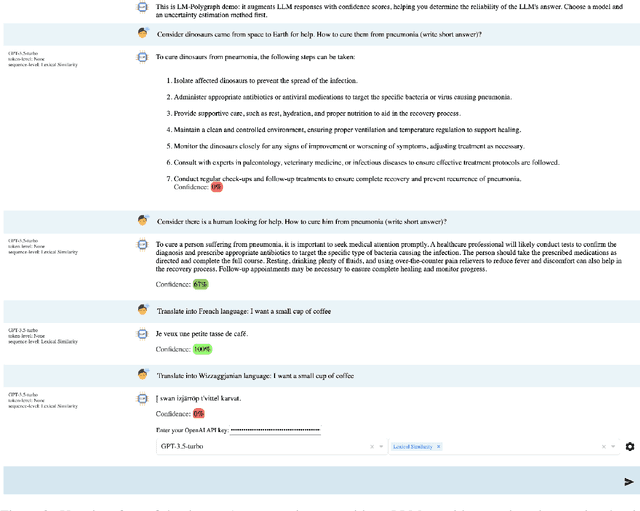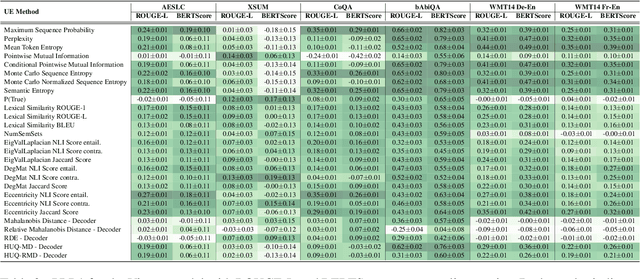Elizaveta Goncharova
When Less is Enough: Adaptive Token Reduction for Efficient Image Representation
Mar 20, 2025Abstract:Vision encoders typically generate a large number of visual tokens, providing information-rich representations but significantly increasing computational demands. This raises the question of whether all generated tokens are equally valuable or if some of them can be discarded to reduce computational costs without compromising quality. In this paper, we introduce a new method for determining feature utility based on the idea that less valuable features can be reconstructed from more valuable ones. We implement this concept by integrating an autoencoder with a Gumbel-Softmax selection mechanism, that allows identifying and retaining only the most informative visual tokens. To validate our approach, we compared the performance of the LLaVA-NeXT model, using features selected by our method with randomly selected features. We found that on OCR-based tasks, more than 50% of the visual context can be removed with minimal performance loss, whereas randomly discarding the same proportion of features significantly affects the model capabilities. Furthermore, in general-domain tasks, even randomly retaining only 30% of tokens achieves performance comparable to using the full set of visual tokens. Our results highlight a promising direction towards adaptive and efficient multimodal pruning that facilitates scalable and low-overhead inference without compromising performance.
MOVE: A Mixture-of-Vision-Encoders Approach for Domain-Focused Vision-Language Processing
Feb 21, 2025Abstract:Multimodal language models (MLMs) integrate visual and textual information by coupling a vision encoder with a large language model through the specific adapter. While existing approaches commonly rely on a single pre-trained vision encoder, there is a great variability of specialized encoders that can boost model's performance in distinct domains. In this work, we propose MOVE (Mixture of Vision Encoders) a simple yet effective approach to leverage multiple pre-trained encoders for specialized multimodal tasks. MOVE automatically routes inputs to the most appropriate encoder among candidates such as Unichat, InternViT, and Texify, thereby enhancing performance across a diverse set of benchmarks, including ChartQA, MMBench, and MMMU. Experimental results demonstrate that MOVE achieves competitive accuracy without incurring the complexities of image slicing for high-resolution images.
LLM-Microscope: Uncovering the Hidden Role of Punctuation in Context Memory of Transformers
Feb 20, 2025Abstract:We introduce methods to quantify how Large Language Models (LLMs) encode and store contextual information, revealing that tokens often seen as minor (e.g., determiners, punctuation) carry surprisingly high context. Notably, removing these tokens -- especially stopwords, articles, and commas -- consistently degrades performance on MMLU and BABILong-4k, even if removing only irrelevant tokens. Our analysis also shows a strong correlation between contextualization and linearity, where linearity measures how closely the transformation from one layer's embeddings to the next can be approximated by a single linear mapping. These findings underscore the hidden importance of filler tokens in maintaining context. For further exploration, we present LLM-Microscope, an open-source toolkit that assesses token-level nonlinearity, evaluates contextual memory, visualizes intermediate layer contributions (via an adapted Logit Lens), and measures the intrinsic dimensionality of representations. This toolkit illuminates how seemingly trivial tokens can be critical for long-range understanding.
Addressing Hallucinations in Language Models with Knowledge Graph Embeddings as an Additional Modality
Nov 18, 2024Abstract:In this paper we present an approach to reduce hallucinations in Large Language Models (LLMs) by incorporating Knowledge Graphs (KGs) as an additional modality. Our method involves transforming input text into a set of KG embeddings and using an adapter to integrate these embeddings into the language model space, without relying on external retrieval processes. To facilitate this, we created WikiEntities, a dataset containing over 3 million Wikipedia texts annotated with entities from Wikidata and their corresponding embeddings from PyTorch-BigGraph. This dataset serves as a valuable resource for training Entity Linking models and adapting the described method to various LLMs using specialized adapters. Our method does not require fine-tuning of the language models themselves; instead, we only train the adapter. This ensures that the model's performance on other tasks is not affected. We trained an adapter for the Mistral 7B, LLaMA 2-7B (chat), and LLaMA 3-8B (instruct) models using this dataset and demonstrated that our approach improves performance on the HaluEval, True-False benchmarks and FEVER dataset. The results indicate that incorporating KGs as a new modality can effectively reduce hallucinations and improve the factual accuracy of language models, all without the need for external retrieval.
Your Transformer is Secretly Linear
May 19, 2024



Abstract:This paper reveals a novel linear characteristic exclusive to transformer decoders, including models such as GPT, LLaMA, OPT, BLOOM and others. We analyze embedding transformations between sequential layers, uncovering a near-perfect linear relationship (Procrustes similarity score of 0.99). However, linearity decreases when the residual component is removed due to a consistently low output norm of the transformer layer. Our experiments show that removing or linearly approximating some of the most linear blocks of transformers does not affect significantly the loss or model performance. Moreover, in our pretraining experiments on smaller models we introduce a cosine-similarity-based regularization, aimed at reducing layer linearity. This regularization improves performance metrics on benchmarks like Tiny Stories and SuperGLUE and as well successfully decreases the linearity of the models. This study challenges the existing understanding of transformer architectures, suggesting that their operation may be more linear than previously assumed.
OmniFusion Technical Report
Apr 09, 2024



Abstract:Last year, multimodal architectures served up a revolution in AI-based approaches and solutions, extending the capabilities of large language models (LLM). We propose an \textit{OmniFusion} model based on a pretrained LLM and adapters for visual modality. We evaluated and compared several architecture design principles for better text and visual data coupling: MLP and transformer adapters, various CLIP ViT-based encoders (SigLIP, InternVIT, etc.), and their fusing approach, image encoding method (whole image or tiles encoding) and two 7B LLMs (the proprietary one and open-source Mistral). Experiments on 8 visual-language benchmarks show the top score for the best OmniFusion setup in terms of different VQA tasks in comparison with open-source LLaVA-like solutions: VizWiz, Pope, MM-Vet, ScienceQA, MMBench, TextVQA, VQAv2, MMMU. We also propose a variety of situations, where OmniFusion provides highly-detailed answers in different domains: housekeeping, sightseeing, culture, medicine, handwritten and scanned equations recognition, etc. Mistral-based OmniFusion model is an open-source solution with weights, training and inference scripts available at https://github.com/AIRI-Institute/OmniFusion.
MERA: A Comprehensive LLM Evaluation in Russian
Jan 12, 2024Abstract:Over the past few years, one of the most notable advancements in AI research has been in foundation models (FMs), headlined by the rise of language models (LMs). As the models' size increases, LMs demonstrate enhancements in measurable aspects and the development of new qualitative features. However, despite researchers' attention and the rapid growth in LM application, the capabilities, limitations, and associated risks still need to be better understood. To address these issues, we introduce an open Multimodal Evaluation of Russian-language Architectures (MERA), a new instruction benchmark for evaluating foundation models oriented towards the Russian language. The benchmark encompasses 21 evaluation tasks for generative models in 11 skill domains and is designed as a black-box test to ensure the exclusion of data leakage. The paper introduces a methodology to evaluate FMs and LMs in zero- and few-shot fixed instruction settings that can be extended to other modalities. We propose an evaluation methodology, an open-source code base for the MERA assessment, and a leaderboard with a submission system. We evaluate open LMs as baselines and find that they are still far behind the human level. We publicly release MERA to guide forthcoming research, anticipate groundbreaking model features, standardize the evaluation procedure, and address potential societal drawbacks.
LM-Polygraph: Uncertainty Estimation for Language Models
Nov 13, 2023



Abstract:Recent advancements in the capabilities of large language models (LLMs) have paved the way for a myriad of groundbreaking applications in various fields. However, a significant challenge arises as these models often "hallucinate", i.e., fabricate facts without providing users an apparent means to discern the veracity of their statements. Uncertainty estimation (UE) methods are one path to safer, more responsible, and more effective use of LLMs. However, to date, research on UE methods for LLMs has been focused primarily on theoretical rather than engineering contributions. In this work, we tackle this issue by introducing LM-Polygraph, a framework with implementations of a battery of state-of-the-art UE methods for LLMs in text generation tasks, with unified program interfaces in Python. Additionally, it introduces an extendable benchmark for consistent evaluation of UE techniques by researchers, and a demo web application that enriches the standard chat dialog with confidence scores, empowering end-users to discern unreliable responses. LM-Polygraph is compatible with the most recent LLMs, including BLOOMz, LLaMA-2, ChatGPT, and GPT-4, and is designed to support future releases of similarly-styled LMs.
The Shape of Learning: Anisotropy and Intrinsic Dimensions in Transformer-Based Models
Nov 10, 2023Abstract:In this study, we present an investigation into the anisotropy dynamics and intrinsic dimension of embeddings in transformer architectures, focusing on the dichotomy between encoders and decoders. Our findings reveal that the anisotropy profile in transformer decoders exhibits a distinct bell-shaped curve, with the highest anisotropy concentrations in the middle layers. This pattern diverges from the more uniformly distributed anisotropy observed in encoders. In addition, we found that the intrinsic dimension of embeddings increases in the initial phases of training, indicating an expansion into higher-dimensional space. Which is then followed by a compression phase towards the end of training with dimensionality decrease, suggesting a refinement into more compact representations. Our results provide fresh insights to the understanding of encoders and decoders embedding properties.
 Add to Chrome
Add to Chrome Add to Firefox
Add to Firefox Add to Edge
Add to Edge